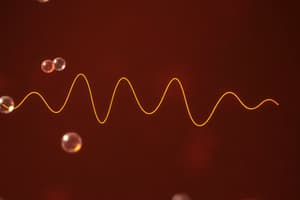Podcast
Questions and Answers
What is the aim of the experiment?
What is the aim of the experiment?
To investigate the effect of changing substrate concentration on the rate of hydrogen peroxide breakdown.
What enzyme breaks down hydrogen peroxide?
What enzyme breaks down hydrogen peroxide?
catalase
What hazards are present in this experiment?
What hazards are present in this experiment?
Cork borer and knife are sharp; hydrogen peroxide 20 vol causes irritation.
How do you get different concentrations of hydrogen peroxide from just 20 vol hydrogen peroxide?
How do you get different concentrations of hydrogen peroxide from just 20 vol hydrogen peroxide?
What is Step 1 of the experiment?
What is Step 1 of the experiment?
What is Step 2 of the experiment?
What is Step 2 of the experiment?
What is Step 3 of the experiment?
What is Step 3 of the experiment?
What is Step 4 of the experiment?
What is Step 4 of the experiment?
What is Step 5 of the experiment?
What is Step 5 of the experiment?
What is Step 6 of the experiment?
What is Step 6 of the experiment?
What is Step 7 of the experiment?
What is Step 7 of the experiment?
What is Step 8 of the experiment?
What is Step 8 of the experiment?
How do you calculate mean?
How do you calculate mean?
How do you calculate standard deviation?
How do you calculate standard deviation?
What did the results show?
What did the results show?
Why does the rate increase as concentration increases?
Why does the rate increase as concentration increases?
Study Notes
Experiment Aim
- Investigate the impact of varying substrate concentration on the rate of hydrogen peroxide breakdown.
Enzyme Involved
- Catalase is the enzyme responsible for breaking down hydrogen peroxide.
Hazards to Observe
- Cork borer and knife are sharp; exercise caution while using.
- Hydrogen peroxide (20 vol) can cause skin irritation; wear lab coats and eye protection.
Preparing Substrate Concentrations
- Use serial dilutions to create different concentrations of hydrogen peroxide.
- Example process: Mix 40ml distilled water with 160ml of 20 vol hydrogen peroxide to obtain 200ml of 16 vol hydrogen peroxide.
- Continue dilution by mixing 100ml of the previous solution with 100ml of distilled water.
Step-by-Step Procedure
- Step 1: Conduct serial dilutions and label beakers accordingly.
- Step 2: Use a cork borer, tile, and knife to cut 20 cylinders of potato, each measuring 2.5 cm, and remove the skin.
- Step 3: Set up a conical flask connected to a delivery tube and an inverted measuring cylinder filled with water.
- Step 4: Place four potato cylinders in the flask, add 2 vol hydrogen peroxide, and secure the bung immediately.
- Step 5: Measure and record the volume of gas released every 30 seconds for 3 minutes.
- Step 6: Dispose of the contents, rinse the flask, and refill the measuring cylinder. Repeat the process for other concentrations of hydrogen peroxide.
- Step 7: Exchange data with peers to collect three measurements for each concentration.
- Step 8: Calculate the mean and standard deviation at 180 seconds and document the values in a table.
Data Analysis
- Mean Calculation: Sum all individual values and divide by the total number of values.
- Standard Deviation Calculation: Use the formula √(sum of(mean - each value)² / (number of values - 1)).
Results Interpretation
- Results indicate that as substrate concentration increases, the rate of reaction also increases until a limiting factor, such as enzyme concentration, is reached.
- Higher substrate concentration leads to a greater number of substrates available for binding, resulting in more enzyme-substrate complexes (ESCs) and quicker product formation.
Studying That Suits You
Use AI to generate personalized quizzes and flashcards to suit your learning preferences.
Description
This quiz focuses on PAG 4.1 in biology, which examines the effect of substrate concentration on the rate of enzyme-controlled reactions. It covers key concepts such as the enzyme involved, hazards, and experimental aims related to hydrogen peroxide breakdown. Test your knowledge on catalase and safety precautions in laboratory settings.



